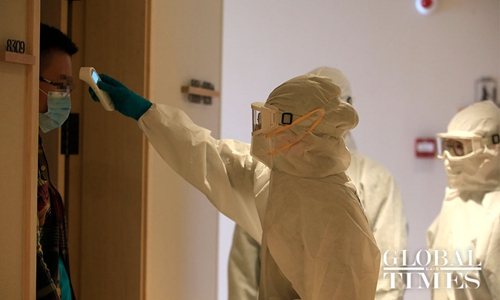Risks of second coronavirus outbreak in China mount
By GT staff reporters Source:Global Times Published: 2020/3/20 18:48:40
Previous virus prevention work should be prolonged: experts

In a centralized quarantine site near Shanghai Hongqiao International Airport, medical personnel have been working round the clock helping to identify possible COVID-19 carriers. Photo: Yang Hui/GT
"Will there be a second COVID-19 outbreak in China?" experts said the answer may be "yes" considering the increasing numbers of imported cases in recent days and the still unknown origin of the virus. They also urged all countries to take effective measures and speed up vaccine development.
China's Hubei Province and its capital city Wuhan, which were both hit hard by COVID-19, have reported zero new confirmed cases for two consecutive days as of press time on Friday, signaling the epidemic is coming under control in China. China reported 39 domestically transmitted COVID-19 cases on Friday. The total number of imported cases in the country now stands at 22.
Wuhan has achieved a phased victory in the battle against COVID-19, but prevention work should not be relaxed. The imported cases situation in China is severe - virus carriers or those in the incubation period could travel to China at any time, which could lead to a second outbreak in China, renowned Chinese epidemiologist Li Lanjuan said to Changjiang Daily on Thursday.
Many experts contacted by the Global Times on Friday shared similar worries over the increasing numbers of imported cases to China in recent days.
Yanzhong Huang, a senior fellow for global health at the Council on Foreign Relations told the Global Times that as the majority of China's population are not immune to the virus, if confirmed overseas cases surge, the epidemic may "revive" in China.
New imported cases have now surpassed new domestic cases in China. There is a large number of Chinese students and nationals living overseas who may choose to return to China if they think foreign governments are incapable of dealing with the pandemic, or because their schools or universities have been suspended, Huang noted.
Huang pointed out that the source of the novel coronavirus is still unknown and that there has been no conclusive information on the intermediate host. How the virus was transmitted to humans remains a mystery. All factors show that we cannot exclude the possibility of the virus beginning anew from the original source.
Huang is uncertain that the virus spread will decrease in high temperatures. "The virus has already spread to countries in the southern hemisphere. These countries will enter winter soon and once there is an outbreak there, it is possible that it will spread to China."
The ideal way to deal with a relapse is to speed up the research and development of a vaccine and effective medicines. But considering safety and efficacy, it usually takes at least one year to develop a vaccine, Huang said.
He noted that another way to deal with a relapse is to build a protective shield. In addition to monitoring passengers arriving on international flights at airports and imposing quarantines, previous virus prevention work should be prolonged.
Zeng Guang, chief epidemiologist of the Chinese Center for Disease Control and Prevention, told the Global Times that cases imported from overseas have posed a challenge, and that it is possible China will see a second wave of the epidemic.
However, as China has strengthened prevention work at airports and residential communities, the possibility may remain low, Zeng said.
Li Lanjuan also warned on Thursday that to avoid possible relapse in Wuhan, local authorities should pay close attention to the prevention work in residential communities and fever clinics, and test all patients with fevers. Once a case is confirmed, the patient and his close contacts should be quarantined.
For five consecutive days from March 13-17, Wuhan reported confirmed cases in fever clinics, which experts said was a "dangerous signal" and exposed some loopholes in residential communities.
Wuhan virologist Yang Zhanqiu told the Global Times that the chances of another large-scale outbreak in Wuhan are small, as Wuhan has gained experience in dealing with scattered cases in residential communities, including receiving patients in hospitals and imposing quarantines on close contacts.
"A sudden outbreak in a residential community could currently be brought under control in Wuhan. But that kind of news may shake the public psychologically as the epidemic has traumatized many. It would also have an influence on authorities' work resumption decisions," Yang said.
Cao Guangjing, vice governor of Hubei, told a press conference on March 18 that enterprises in Wuhan can resume work no earlier than 12 midnight on March 20, Chutian Metropolis Daily reported.
Yang said that effectively monitoring and preventing a possible outbreak after enterprises resume to work is a problem that urgently needs to be solved. In addition to using health codes, enterprises should strengthen prevention work for individual employees.
Hubei on March 10 rolled out a color-coded health rating system for individuals in the province, encouraging people with low health risks to return to work as the epidemic situation in the province is easing. The health codes classify residents as healthy (green); a close contact with a confirmed case (yellow); or a confirmed case, a suspected case, or an individual showing COVID-19 symptoms including fever (red).
Newspaper headline: Risks of 2nd outbreak in China mount